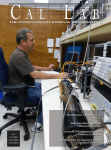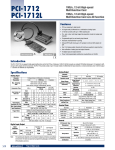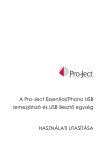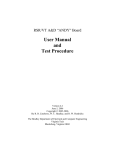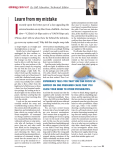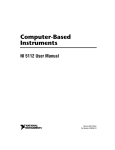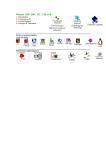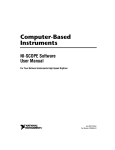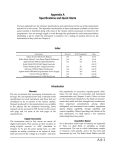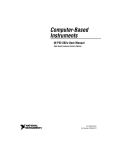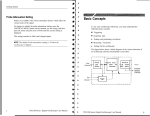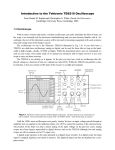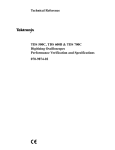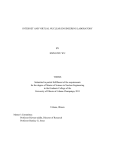Download Form, fit, & function in $1500 DSOs
Transcript
Pico Scopes Distributed by: Interworld Electronics & Computer Ind. [email protected] Page 1 of 8 Test & Measurement World, February 2002 Form, fit, & function in $1500 DSOs We looked at four low-cost DSOs in handheld, PC plug-in, PC external, and benchtop formats with similar specs. By Brian Kerridge, Editor, Test & Measurement Europe and Martin Rowe, Senior Technical Editor If you’re buying a low-cost digital storage oscilloscope (DSO) and have a budget of around $1500, you have several form-factor options: handheld, PC plug-in, PC external, or benchtop. Each form factor has special requirements. Handheld DSOs must be small and robust. Designers of PC plug-in cards must shrink measurement circuits, and the cards need to operate within the noisy PC environment. PC plug-ins and PC externals both abandon conventional front-panel controls and displays for mouse, keyboard, and monitor operation. Benchtop formats may suffer none of these compromises, but manufacturers have to balance features against price to compete in the low-cost market. With these issues in mind, we assessed the measurement performance and usability of these four low-cost DSOs: • Fluke handheld 123 ScopeMeter ($1195); • National Instruments PCI plug-in NI 5102 ($1295); • Pico Technology PC module ADC-212/100 ($1079); and, • Tektronix benchtop TDS210 ($1195). Table 1 compares the key specs of these instruments. For a summary of what’s included in each standard package, see below. We recommend that you use the DSOs in this class for monitoring and recording known signals but not to probe for the unknown. One unit has <[email protected]> Table 1. Dual-channel DSOs in handheld, PC, and benchtop formats Company Fluke National Instruments Pico Technology Tektronix Format handheld PCI plug-in PC module benchtop Model 123 NI 5102 (with NI- ADC212/100 TDS 210 2002-02-05 Page 2 of 8 Pico Scopes Distributed by: Interworld Electronics & Computer Ind. [email protected] a shortage of digitizing speed, and another has short memory length; such limitations diminish the appeal of these units for use in design applications. But if you need a scope for waveform monitoring or simple troubleshooting, these instruments should meet your technical and budgetary requirements. Price vs. features You might expect a benchtop instrument to have many pros and few cons. The TDS210 occupies little bench space and is the easiest to use. To achieve the competitive price, though, Tektronix made some compromises. For example, you get just 2.5 ksamples of memory per channel, far less than you get with a larger scope. In addition, you can’t output records or remotely program the TDS210 unless you buy options. The options will cost you around 50% of the base unit alone. So, while you may prefer a benchtop instrument, the final price of the Tek TDS210 may exceed your budget. Scope Soft Front Panel software) (with PicoScope software) Bandwidth 20 MHz 15 MHz 50 MHz 60 MHz Max. sampling rate 25 Msamples/s 20 Msamples/s 100 Msamples/s 1 Gsample/s Record length/channel 512 samples 331 ksamples 128 ksamples 2.5 ksamples Vertical resolution 8 bit 8 bit 12 bit 8 bit Basic DC accuracy ±2% ±2.5% ±1% ±3% Input sensitivity 5 mV to 500 V/div. 12.5 mV to 1.2 V/div. 2 mV to 2 V/div. 2 mV to 5 V/div. Max input 600 V rms ±42 V ±100 V ±300 V Timebase 20 ns to 5 s/div. 5 µs to 100 ms/div. 100 ns to 50 s/div. 5 ns to 5 s/div. Zoom No No Yes Yes Size (in.) 9.1 h x 4.5 w x2d PCI/ISA plug-in card 5.5 h x 7.5 w x 1.8 d 6 h x 12 w x 4.75 d Weight (lbs) 2.5 Not applicable 0.8 3.2 Power supply mains adapter or rechargeable (5 hr) 5 V, 260– 500 mA mains adapter (battery optional) mains PC plug-ins and externals rely on the host computer for their display, power supply, front panel, and possibly their $1,195 $1,295 $1,015 $1,195 Price enclosure. As a result, you can often enjoy benchtop performance at a much lower cost. Pico’s ADC-212/100 PC-external DSO delivers and it’s a good value. In fact, it’s the only unit we used that has 12-bit vertical resolution and 61% vertical accuracy. Its software lets you operate the module as a scope, spectrum analyzer, DMM, or square-wave generator. Surprisingly, National Instruments’ NI 5102 PCI plug-in DSO, which you would imagine has the lowest manufacturing cost, comes out as the most expensive unit we tried. It is also the most limited in bandwidth, sampling rate, and input voltage. In its favor, though, the NI 5102 has the highest record length per channel by far—331 ksamples. You can extend the record length to 16-Msamples by using the PC’s internal memory. Because it is a plug-in card—and is available in PCI, PXI, USB, ISA, and PC Card formats—the NI 5102 offers the best connectivity and system-integration possibilities. Fluke’s ScopeMeter 123 is a good example of a versatile handheld instrument. From a performance-only viewpoint, though, you’d never choose it because of its low bandwidth and sampling rate. Furthermore, its record length—512 samples/channel—is positively minute, and its display is small. What Fluke compromises in speed and memory, it makes up for in electrical and mechanical protection. Input voltage protection is often an underrated instrument feature, but it is certainly important on this DSO. Users commonly measure AC mains voltages, and carefree probing with the other DSOs we tried spells instant death to the unit. The Fluke unit, though, handles these voltages without incident. As a further plus, handheld units use batteries, so you have no concern about ground loops, common mode errors, or safety isolation on your measurements. As a bonus, the ScopeMeter also provides a 5000-count DMM. <[email protected]> 2002-02-05 Pico Scopes Distributed by: Interworld Electronics & Computer Ind. [email protected] Page 3 of 8 Ease of use is essential If you’re a bench-hardened veteran, you’ll feel at home with the benchtop TDS210. PC-based DSOs just can’t match the feeling of satisfaction and precision that you get when you adjust a scope with a knob. You simply don’t need handbooks or help files to operate this DSO. The only notable limitations concern the TDS210’s display. The eight vertical grids by 10 horizontal grids, although bright and with good contrast, have a narrow viewing angle. Viewed from directly in front, the black-andwhite (B&W) LCD is easy to read. But readability quickly diminishes as you move off center. The fold-out feet tilt the case up by 208; an adjustable angle would make the display more visible. Fluke’s handheld ScopeMeter 123 also has an 8x10 display graticule (or more accurately, about 91/2 visible horizontal divisions on the model we used). The display’s brightness, though, is a drawback. Even with the backlight on, you’ll need to shield the display when taking readings in bright light. Fluke designers made the 123 easy to use with only 20 front-panel buttons. The standard Tek and Fluke units lack connectivity when you need to record waveforms. Considering these units will find use primarily as waveform monitors rather than as design tools, this lack of connectivity isn’t a problem. Both units can store waveforms and front panel setups, but you’ll need to purchase additional attachments to download records to a PC. Without these attachments, the units limit you to storing just one waveform per input channel. The Fluke unit lets you store 10 front-panel user setups; the Tek unit stores five. Data storage lends an inherent advantage to the PC plug-in and PC-external DSO formats. Effectively, you get free waveform recording with unlimited storage. The NI-Scope Soft Front Panel (SFP) software version 1.5, which now ships with the NI 5102, lets you save waveform data to a file for analysis in a spreadsheet or math package. Although SFP 1.5 lets you store waveforms, it doesn’t let you recall waveforms to the display. Although PC displays suffer none of the viewing limitations of the 100-mm LCDs on the Fluke and Tek units, NI’s SFP 1.5 currently prevents you from maximizing your display window, and the software lacks measurement cursors and waveform zoom facilities, SFP also prevents you from shifting the waveform relative to the graticule—such shifting is an analog scope legacy that lets you use the graticule for rough amplitude measurements. To its credit, though, NI’s SFP lets you choose from up to 40 different waveform measurements per channel in a separate window. Pico Technology’s ADC-212/100 PC external module doesn’t have the constraints of the NI plug-in. The PicoScope software lets you store unlimited numbers of waveforms or measurements, and you can maximize the 10x10 graticule and virtual front panel to take advantage of a PC’s large display. You also can select the colors for each trace, background, and cursor. What you win on display with PC externals and plug-ins, though, you lose on usability. Fingers on knobs and buttons will always beat mouse or keyboard operation. Although NI’s SFP and Pico’s PicoScope software make the PC units easy to use, you have to accept Windows-style pull-down menus to set up your scope. NI also provides shortcut keys on your keyboard to operate these controls. Zoom highlights differences Operating on the theory that this class of instrument best suits monitoring work, we tested the units using video signals and noise signals. On all units, the “automatic setting” located an initial waveform that we then adjusted manually to give similar displays across all units. We looked at the color-sync burst of a video signal using the DSO zoom feature of the Tek and Pico units. (Fluke’s handheld unit and NI’s PC plug-in have no display zoom so they couldn’t undertake this test.) This measurement highlighted differences between the Tek and Pico units. The color burst—the ripple in Figure 1 that follows the low-going sync pulse—should be 8 to 11 cycles long. We wanted to see how well the Tek and Pico scopes could zoom in on the 4.43-MHz color burst. The <[email protected]> 2002-02-05 Pico Scopes Distributed by: Interworld Electronics & Computer Ind. [email protected] Page 4 of 8 TDS210 displayed a waveform that varied wildly, and the trace broke down into individual dots (Figure 2). Pico’s PC-external DSO, with 12-bit resolution, produced a particularly good waveform at a similar magnification (Figure 3). Using the cursors set on the 11 cycles of Pico’s zoomed waveform, we measured a frequency of 4.49 MHz against a 4.43 MHz target color-burst signal. We ran a test to check the internal noise of all four scopes. You can easily apply this test to any DSO by connecting a terminated short at the input BNC. The NI 5102 showed slightly more noise, and using its peak-to-peak measurement facility, we read 1.95-mV pk-pk on the DSO’s 12.5-mV/div lowest range. In a similar test, Tek’s TDS210 showed 1.8 mV pk-pk at 2 mV/div (and strangely, this varied with timebase Figure 1. A typical video signal on the Pico ADCsetting). Even on all the higher volts/div ranges, the 212/100 prior to using zoom. Tek unit always showed a quarter of a graticule’s worth of fuzz. Fluke’s 123 measured 0.0 mV pk-pk on 5 mV/div, although we observed a tiny ripple on the trace. Pico’s ADC-212/100 measured 318 mV pk-pk on a 1-mV/div setting. To put the results of the noise test into perspective, we ran the test on a 20-year-old analog scope. Our HP1740A displayed far less internal noise than any of the DSOs we tested. On a 1-mV/div setting, we could see about 200 mV of pk-pk noise. Strengths and weaknesses If you really need a portable and rugged instrument, then give strong consideration to Fluke’s ScopeMeter Model 123. It is easy to use, but its measurement Figure 2. The Tek TDS210 zooms in on the same capability is a bit limited compared with the others. Tek’s benchtop TDS210 is a pleasure to use, but the signal as in Figure 1 but shows large amplitude variations and individual waveform points. internal noise displayed on the unit we used—even on higher ranges—put us off. National Instruments’ NI 5102 performs well, but its 15-MHz bandwidth and 20-Msamples/s rate give you the lowest specs for the highest cost of the DSOs we used. Also, we think the lack of a waveform recall ability in the SFP 1.5 software is a significant drawback. The plug-in card’s system’s integrative potential is one feature that the other formats can’t rival. It’s hard to find fault with Pico Technology’s ADC212/100, except that you do have to live with a rather unspectacular-looking plastic box. The box belies what must be within though, because the software gives you other virtual instruments, and its specs fall at the better end of the range, even with the lowest price of the units we tested. T&MW Figure 3. Zooming in on the 4.43-MHz color burst sync section with the Pico ADC-212/100 produces a respectable waveform. Brian Kerridge has been writing on electronics design and test for 10 years with both EDN and Test & Measurement Europe magazines. He has 25 years of experience in design, engineering management, and marketing of T&M, machine control electronics, and military radar. He is a Chartered Engineer and MIEE. <[email protected]> 2002-02-05 Pico Scopes Distributed by: Interworld Electronics & Computer Ind. [email protected] Page 5 of 8 Martin Rowe has a BSEE from Worcester Polytechnic Institute and an MBA from Bentley College. Before joining T&MW in 1992, he worked for 12 years as a design engineer for manufacturers of semiconductor process equipment and as an applications engineer for manufacturers of measurement and control equipment. E-mail: [email protected]. Sampling rate rolls off Although tens of Msamples/s sounds like a lot of sampling is going on, in fact DSOs of all classes can only maintain their real-time sampling rates if there is an adequate record length/channel. As an example, for the Tektronix DSO in this survey, the 1-Gsamples/s rate operates with only 2.5 ksamples/channel buffer memory, which means the DSO can sample at full speed for only 2.5 ms—a 400-kHz waveform period—before its memory buffer is full. To record for longer, this DSO has to spread its available record length over increasingly longer periods and, in consequence, reduce its sampling rate each time you increase the timebase setting. The chart shows how the sampling rates of all the DSOs in our survey roll off with timebase setting. Fluke’s ScopeMeter 123 This DSO feels and looks as if it’s virtually indestructible and it certainly lives up to its Industrial ScopeMeter title. It’s easy to operate although it has only twenty buttons to control its many functions. Performance is basic, though, most notably with only 512 samples/channel. Compared against the other DSOs it lacks cursors and zoom. It does measure inputs up to 600 V RMS though, and has an in-built 5000-count DMM. The DMM measures Ohms, continuity, diodes, dBV, dBm, crest factor, and amps and temperature with optional probes. The unit also graphs max/min readings from 120 s to 16 days. Although the 123 has a 20-MHz input bandwidth at its BNC terminals, the standard probes supplied by Fluke limit measurements to only 12.5-MHz bandwidth. You’ll have to buy the optional 10:1 probe kit to get the full bandwidth. If you need to link up your 123 to a PC to archive results, for example, then you’ll also need the optically-isolated RS-232C adapter/cable. Battery power runs the unit for five hours (four hours with backlit LCD) and takes four hours to recharge (with the unit off). A useful “battery refresh” feature allows you to put the batteries into an internal 12-hour cycle, which fully discharges and then recharges them. What you get for $1195: Handheld DSO/DMM, Ni-Cd pack, power adapter/charger, 1:1 probe kit, 70-page users' manual. The printout via the optically-isolated RS-232C interface replicates the display with a secondary ignition automotive signal input. Contact: Fluke, Everett, WA. 425-347-6100; www.fluke.com. National Instrument’s NI 5102 This DSO, or digitiser as NI prefers it, is easy to operate with pull-down menus or shortcut keys. A selectable context help window is useful for reminding novice users what controls <[email protected]> 2002-02-05 Pico Scopes Distributed by: Interworld Electronics & Computer Ind. [email protected] Page 6 of 8 what as you manoeuvre your mouse pointer over the display. The wide range of around 40 preset measurements that you can apply to waveforms is a particular strong point, and displaying these measurements as a list in a separate window neatly keeps the main virtual front panel uncluttered. NI is currently revamping the software that supports its NI 5102 hardware and NI-Scope Soft Front Panel has replaced the earlier VirtualBench-Scope. Several earlier standard features such as zoom, maximised window, and cursors have yet to be added to the SFP. The issue 1.5 available for our survey allows you to store waveform data, but not recall waveforms to the display. The software revamp employs Hierarchical Data Format (HDF), which will allow you to use third-party applications that support HDF to access stored waveforms. In this file format, you can store full details of waveforms such as vertical range, sampling rate, trigger information with your data. The great advantage of this digitiser is its 331ksamples/channel record length, which in the future you can expand to 16-million samples if your PC has 48 Mbytes of free RAM. This unit’s real strength is as a dedicated systems digitiser, though, and it comes in other systems formats such as CompactPCI, PCMCIA, and USB. It’s also compatible with NI’s LabView and Measurement Studio, and with MS-Visual C/C++ and Visual Basic. Overall, this digitiser is pleasant to use but it’s costly for what is quite a modest measurement specification in this class of instrument. What you get for $1295: PCI plug-in card, NIScope soft front panel (SFP) software 1.1, switchable x1/x10 probes, user manual, software user manual. SFP usefully displays the actual sampling rate on each timebase setting. Contact: National Instruments, Austin, TX. 512-794-0100; www.ni.com. Pico Technology’s ADC-212/100 This unit is the only one in the survey with 12-bit vertical resolution and it shows as generally smoother waveforms. It also shifts the 0.4% theoretical limit with 8-bit resolution DSOs down to less than 0.1%. The DSO also usefully includes a record length of 128 ksamples/ channel, or 256 ksamples to a single channel. Zoom operates on both X and Y scales. A useful “save-to-disk-on-trigger” function allows you to trap, record, and time/date intermittent events over long periods. The unit also includes as standard a square wave generator, a 50MHz 4096-point spectrum analyser, a 4-digit true RMS DMM, and a transient recorder. Getting this DSO running, including loading the PC software, is straightforward and takes less than two minutes. The software, with free downloads, includes 35 automatic measurements, including rise time, pulse width, duty cycle, THD, SNR, and SINAD. A 5-hour battery pack is optional and makes this unit reasonably portable when used with a laptop. Pico’s unit is compatible with C/C++, Delphi, Visual Basic, LabView, Agilent Vee, Linux, and Excel. In Excel, a macro allows you to directly collect data without scope or logging software. <[email protected]> 2002-02-05 Pico Scopes Distributed by: Interworld Electronics & Computer Ind. [email protected] Page 7 of 8 What you get for $1079: PC Scope module, switchable x10/x1 probe kits, PicoScope software CD, mains adapter, parallel cable, user's handbook. Contact: Pico Technology, Cambridgeshire, UK. www.picotech.com. Sold in North America through Interworld Electronics. 877-902-2979; www.interwld.com . The 12-bit resolution provides more amplitude detail to the secondary ignition automotive input signal compared with the other DSOs in this class. Tektronix’s TDS 210 This DSO has the “feel” of a regular bench scope. It’s pleasant to use and has a bright LCD. Its strengths are its 60-MHz bandwidth and 1Gsamples/s sampling rate, although its limited 2.5-ksamples/channel record length rather negates the sampling rate advantage. Automatic measurements include period, frequency, RMS, mean, and peak-topeak. Zoom operates in both X and Y scales. Giving this DSO some connectivity, or expanding its measurement capability, makes its already higher cost start to get expensive. The field-fittable TDS2CM communications module adds a Centronics parallel port, RS-232C, and IEEE-488 programmability. Module TDS2MM adds the previous I/O and also a 2048-sample FFT, and automatic measurements of rise/fall times, and positive and negative pulse widths. If you want to operate the DSO from a PC, you’ll also need WaveStar PC software.The Tek screen shots included in this survey came via the parallel printer output and don’t do justice to the neatness of the DSO’s display. Apart from cost, the only real concern you might have about this DSO is its visible trace noise, which makes you want to reach for a focus control. The printout using the “hard copy” button shows all details of the DSO’s display using the secondary ignition automotive input. What you get for $1195: Benchtop DSO, x10 probes, user's manual. Contact: Tektronix, Beaverton, OR. 800-426-2200; www.tektronix.com. Copyright 2002, Test & Measurement World. Published by Cahners Business Information, Newton, MA. Copyright © 2002 Cahners Business Information, a division of Reed Elsevier. All rights reserved. Privacy Policy Trademark Information & Terms of Use <[email protected]> 2002-02-05 Pico Scopes Distributed by: Interworld Electronics & Computer Ind. [email protected] Page 8 of 8 Test & Measurement World, 275 Washington Street, Newton, MA 02458-1630, USA Tel: 617-558-4671 Fax: 617-558-4470 E-mail & Webmaster: [email protected] Web Site Developer: WebGrow <[email protected]> 2002-02-05









